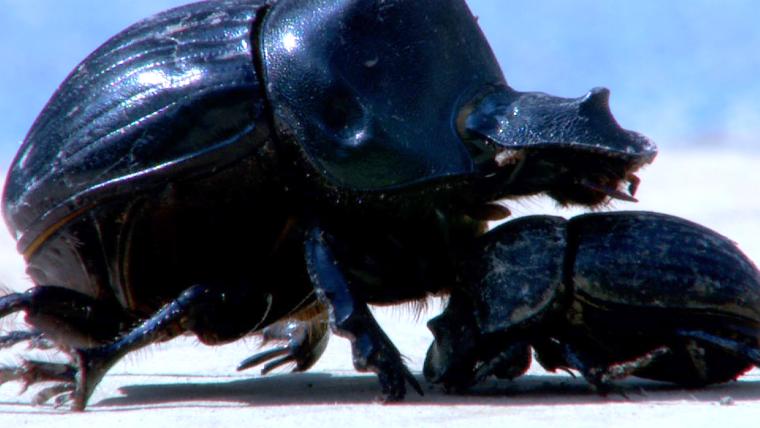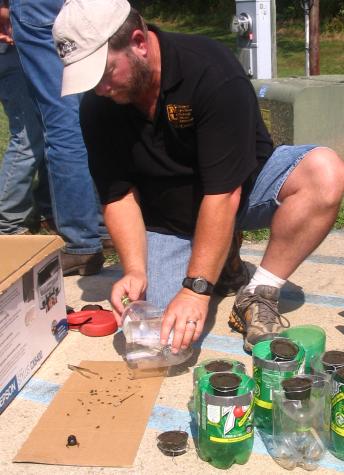Field day looks at nature's cleanup crew
Writer
Curt WohleberCOOK STATION, Mo. – For people, cowpats are smelly obstacles, but some creatures call them home.
“To dung beetles, a dung pat is an ephemeral island in a hostile sea of grass,” said University of Missouri research associate Kent Fothergill at a recent dung beetle field day at MU Wurdack Farm in the Ozarks.
About two dozen people spent the day learning about dung beetles and the helpful role they can play on cow pastures.
Dung beetles do more than make short work of cowpats littering pastures. “They improve soil structure, help control flies and other livestock pests, and recycle nutrients that otherwise would be lost,” said Wayne Bailey, MU Extension state entomologist.
There are about 5,000 species of dung beetle throughout the world. They all like to eat dung, but some live inside dung pats, others tunnel beneath them while still others, the “rollers,” grab bits of manure, form them into little balls and, as Fothergill puts it, “take their little piece of heaven and run away with it.”
Dung beetles once were far more plentiful on American pastures, but the widespread use of certain drugs to worm cattle turned the manure of treated livestock into a lethal environment for the beetles.
In recent years, however, pastures have become more hospitable, with more producers using different wormers or timing treatments so they are less damaging to the beetles.
Because modern pastures can support more livestock, native dung beetle species may not be able to keep up with the increased manure production. In the 1980s, USDA scientists in Texas experimented with importing species from abroad to help pick up the slack. Among the imports was gazella, an African beetle so voracious that just a few hundred of them can dismantle 150 pounds of elephant poop in less than 24 hours. Some farmers pay hundreds of dollars—about a buck a beetle—to buy starter colonies of gazella and similar species for their pastures.
Ralph Voss, an Osage County farmer and self-described “dung beetle enthusiast” talked at the field day about his experience with dung beetles on his farm. Voss encourages producers to swap beetles with other farmers to establish a healthy mix of species. A diverse beetle population—with differing feeding habits based on factors such as time of day, weather and climate, freshness of dung and the livestock’s diet—can promote a more efficient division of labor, meaning quicker removal of manure.
However, as yet there is no reliable formula for maintaining a thriving dung beetle population on your farm. Creating ideal conditions for one species may be disastrous for another. That’s why Bailey is working with farmers, extension specialists and researchers such as Fothergill to collect data about dung beetle populations across Missouri.
“The questions are huge,” said Fothergill, who has trapped dung beetles from pastures near MU’s Delta Research Center in Portageville. He sees the cowpat as a scientific frontier awaiting researchers with the funding and fortitude to explore it. “They’re neat little model ecosystems that can help us answer big ecological questions.”
Other speakers at the field day included Tanja McKay, a veterinarian and entomologist at Arkansas State University. Her research team, which collected and studied dung beetles from Arkansas pastures, was featured last year in an episode of the Discovery Channel television series “Dirty Jobs.”
Kelly Tindall, research entomologist at the MU Delta Center, told how dung beetles help in grazing systems by improving plant growth, reducing nutrient runoff and making more forage available to livestock.
Veterinarian Jody Wade of St. Joseph-based Boehringer Ingelheim Vetmedica Inc. talked about the livestock wormer moxidectin, a “dung beetle friendly” alternative to ivermectin.
After the presentations, attendees got to examine the contents of dung beetle traps placed in Wurdack Farm pastures that morning. In just a few hours the traps had snagged a wide assortment of beetle species, from a tiny Labarrus pseudolividus to the walnut-sized Dichotomius carolinus.
###

